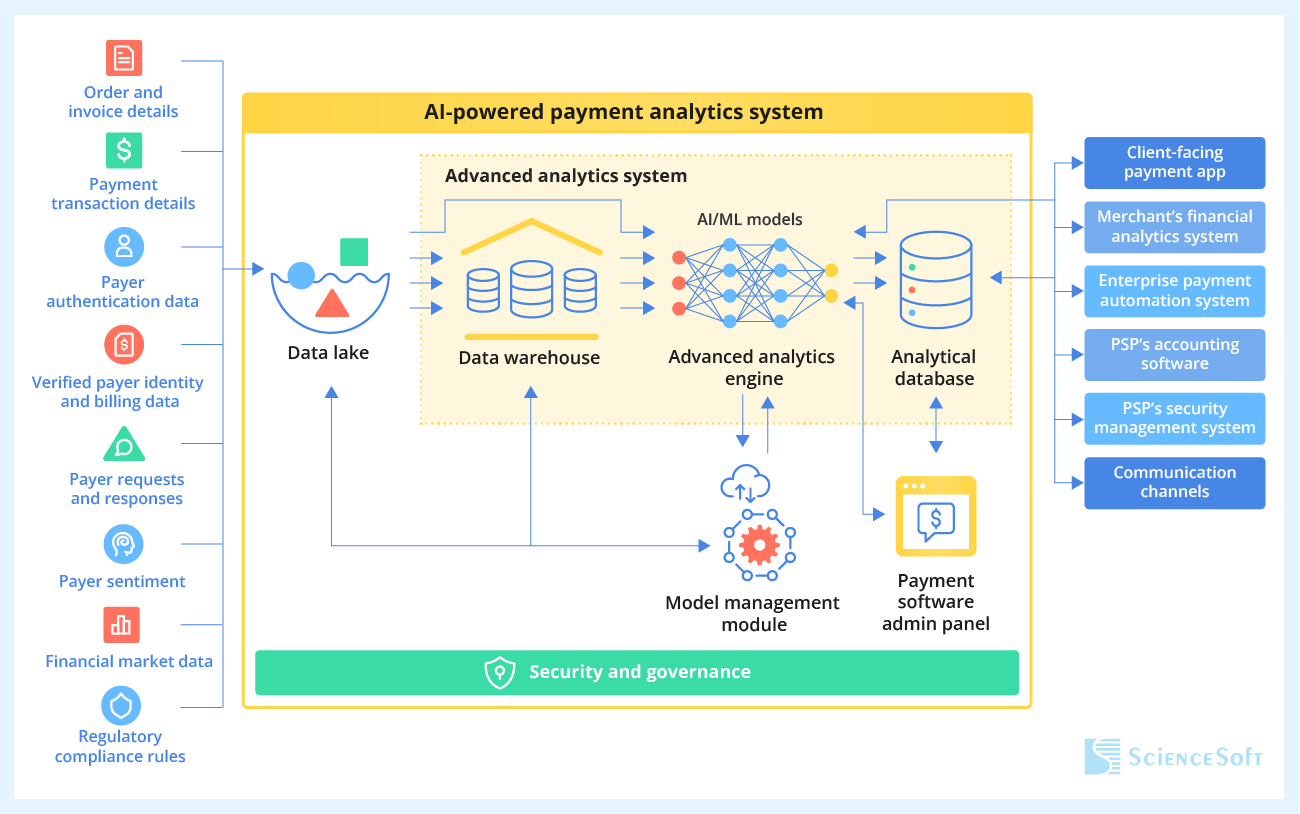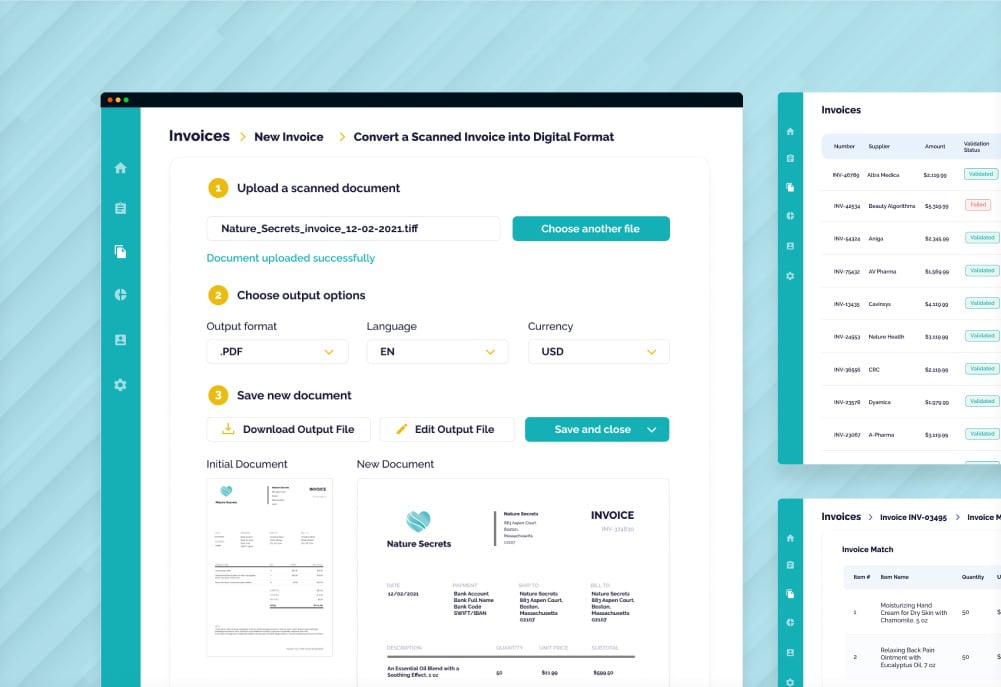Artificial Intelligence (AI) in the Payment Industry
ScienceSoft relies on 36 years of experience in artificial intelligence and 20 years in payment software engineering to design and build tailored payment automation solutions powered by advanced AI technologies.
Artificial Intelligence in Payments: The Essence
Artificial intelligence for payments automates payment document processing, transaction routing, dunning, and reconciliation workflows, bringing a 5–45% increase in payment service provider (PSP) teams’ productivity.
AI solutions can handle KYC/AML verification in minutes and instantly spot identity and payment fraud, which allows PSPs to reduce fraud-associated financial losses by more than 50%. Using AI-powered analytics, PSPs can optimize payment processing costs and deliver personalized customer experiences, driving higher payer satisfaction and retention. Introducing AI for enterprise payment functions enables more accurate cash flow forecasting, 80%+ faster accounts payable procedures, and up to 50% reduction in days sales outstanding.
AI in digital payments is largely focused on upgrading customer self-service options. While PSPs like banks, non-bank payment firms, and paytech companies are the ultimate beneficiaries of AI, consumers also benefit from increased payment convenience and enhanced funds safety.
AI in the Payment Industry: Market Overview
The global market of artificial intelligence for the BFSI industry was valued at $26.2 billion in 2024 and is projected to hit $192.7 billion by 2034, growing at a CAGR of 22%. Being one of the early adopters of AI, the payment sector benefits from improved operational efficiency, accurate fraud detection, and enhanced customer experience.
The main driver for the popularity of AI-powered payment solutions is the increasing demand for convenient and secure e-payments. The PSPs’ need to process growing volumes of payment transactions and stop the rising tide of fraud contributes to the growing adoption of AI. ISO 20022 and new regulatory frameworks like PSD3 are widely anticipated to catalyze AI-driven sectoral innovations.
Finastra stresses that AI has been used in payment processing for years but only as part of larger solutions. As such, AI did not receive much attention before the appearance of generative and agentic AI. The rise in GenAI paves the way to new payment use cases. As per Capgemini’s World Payments Report 2026, 60% of paytech firms have deployed GenAI to leverage the technology for more effective payment service operations.
10 Main Vectors for AI Adoption in Payments
AI can be used to monitor the most recent payment information, reconcile the received payments, identify failed and due payments, and notify payment chain participants of the necessary actions. Intelligent payment processing automation helps reduce low-value routines and speed up payment workflows.
Optical character recognition (OCR) and natural language processing (NLP) techs can automate the capture and processing of invoices, checks, and other documents in various formats, including CSV, XML, PDF, digital images, and handwritten text. AI can instantly route valid documents for approval and enforce approved payments.
Payment optimization
AI can advise consumers and businesses on the optimal payment channels and timings based on analyzing transactional fees, settlement speed, and anticipated currency exchange rates (for cross-border payments).
Payer experience personalization
AI-powered demand and behavior analytics help define individual payment patterns and better understand payer needs. AI-supported payer journey personalization helps improve retention and prevent abandoned checkouts.
Payment customer communication
AI-enabled virtual agents can handle up to 60% of customer interactions and provide instant 24/7 support. Virtual assistants can inform payers about new payment options, request missing payer data, communicate tailored offers, and more.
KYC/AML verification for payers
Machine learning algorithms can auto-validate the data from customer digital documents against reliable third-party sources (e.g., bank systems). AI can perform AML/CFT and OFAC screening for new customers.
Fraud detection and prevention
Intelligent image analysis algorithms can validate payer biometrics (facial images, fingerprints) and authenticate payers. AI can spot fraudulent payment patterns in real time and instantly apply preventive measures (e.g., block a suspicious transaction or a compromised account). Generative AI helps identify advanced identity fraud like deepfakes.
Payment compliance
AI can monitor payment data processing compliance with the required standards (PCI DSS, 3D Secure, PSD2/3, corporate policies, etc.) and instantly report non-compliance to responsible parties. AI-supported payment data standardization (validation, cleansing, enrichment, and conversion to the structured format) simplifies adherence to ISO 20022.
Payment network performance control
AI-supported tools can identify anomalies in the payment network traffic and alert PSPs’ security teams about potential cyberattacks. AI can also predict network failures and advise on the necessary maintenance procedures, preventing service downtime.
Enterprise cash flow analytics
Machine learning engines help forecast liquidity and accurately plan cash outflow based on the projected customer payment dates and amounts. They can also automate A/R collection activities to accelerate cash inflow and prevent bad debt. Generative AI can aid in crafting personalized dunning notifications.
Sample Architecture for an AI Payment Solution
ScienceSoft creates AI-powered payment solutions with secure and scalable architectures that enable straight-through processing of payment data. Below, our consultants share a sample architecture of AI software for multi-faceted payment analytics.

- Payment-associated data (transaction details, payer authentication data, verified payer identity data, payer requests, financial market data feeds, etc.) gets automatically captured from the available sources and transferred to the data lake for storage in its raw format.
- The data is instantly routed to the analytics system for preprocessing (filtering, cleansing, enrichment). The clean and structured data is then stored in a data warehouse.
- Data scientists use data from the data lake and the data warehouse to train payment AI models. Most AI application areas in payments involve complex predictive and prescriptive tasks that assume employing neural networks (NN), including advanced models like deep reinforcement learning for payment optimization. Model engineering, training, and performance control occur in the model management module.
- An advanced analytics engine with pre-trained NN models at its core analyzes the payment data, reveals transactional patterns and anomalies, introduces predictions on the required metrics and events (payer behavior, transaction cost, payment gateway load, etc.), and prescribes the optimal actions.
- Model outputs are routed to the analytical database for storage. They are instantly communicated to the PSP’s teams (via web and mobile payment software admin interfaces) and integrated client-facing systems (e.g., consumer payment apps, enterprise payment automation systems, or merchants’ cash flow analytics systems).
- NN payment models use analytical outputs and user feedback (e.g., fraud alerts flagged as false by humans) for continuous self-learning.
Explore ScienceSoft’s Featured Success Story

AI Software for Fully Automated Processing of Payment Documents
ScienceSoft designed and developed high-performing AI software for a US technology company offering intelligent solutions for accounts payable automation. Key software features include:
- Automated uploading of multi-format invoices from emails and connected systems.
- OCR-enabled capture and extraction of numeric and textual invoice content.
- AI-powered validation of invoice data (number, date, price, etc.).
- Identifying and reporting invoice exceptions.
- Automated routing of valid invoices for multi-department approval.
- Automated invoice routing for payment.
- Payment data encryption, multi-factor user authentication, role-based access control.
Major Considerations for Successful Payment AI Launch
Below, ScienceSoft’s AI consultants outline two critical factors driving the ROI of artificial intelligence in the payment industry:
High accuracy of AI models
Low-accuracy AI models may fail to adequately interpret payment data and correctly predict the required variables. This may compromise the value of consequent forecast-driven actions. Achieving the output precision of above 90% requires:
- Composing a comprehensive training dataset. The dataset should include your company’s proprietary data so that the model considers your operational specifics when making predictions and enforcing decisions. Covering edge and non-standard payment scenarios helps broaden the model’s recognition capacity and maximize the degree of straight-through issue resolution.
- Adequately configuring model hyperparameters. Balanced hyperparameters prevent model under- and overfitting. If we take AI-supported payment fraud detection as an example, poorly fitted models will cause false positives, hampering the payer experience and false negatives, resulting in overlooked fraud. Applying optimization, cross-validation, and iterative tuning helps to assess the model’s quality and gradually refine its hyperparameters.
AI software security
AI has much to offer for cybersecurity, but it doesn’t mean that AI-powered payment software is secure by default. Employing the following protective mechanisms will ensure the security of your payment AI solution and the sensitive data it operates:
- Role-based access control for payment app users.
- Multi-factor authentication, including biometric authentication (applies to both payment software users and admins).
- End-to-end payment data encryption, including asymmetric encryption.
- Blockchain-supported primary account number (PAN) tokenization.
- IDS/IPS, firewalls, and user and entity behavior analytics (UEBA) for payment processing networks and payment app infrastructures.
- SIEM tools for complex financial IT infrastructures hosting multiple payment solutions (e.g., banking IT infrastructures).
Costs of AI-Supported Software for Digital Payments
From ScienceSoft’s experience, building a custom AI solution for payments may cost from $70,000 to $650,000+, depending on software features, the number and complexity of AI models, the scope of integrations, and requirements for performance, scalability, security, and compliance.
Here are some examples of our ballpark estimates:
$70,000–$200,000
A standalone AI component (e.g., for payer behavior forecasting or fraud detection) integrated into a full-scale payment solution.
$150,000–$300,000
A mobile payment app powered by a generative AI chatbot that handles customer assistance and support.
$450,000–$650,000+
Complex AI-powered software that enables real-time processing of payment data, prescribes the optimal payment channels and timing, and automates payment execution.
Payment AI Consulting and Implementation by ScienceSoft
In artificial intelligence software development since 1989 and in payment software development since 2005, ScienceSoft delivers robust AI solutions for payments, ensuring that the project goals and budget are met.
About ScienceSoft's AI Practice
ScienceSoft is a global AI software development company headquartered in McKinney, Texas. We deliver AI solutions for fast, efficient, and secure payment flows. In our AI projects, we rely on robust quality management and security management systems backed up by ISO 9001 and ISO 27001 certifications.








